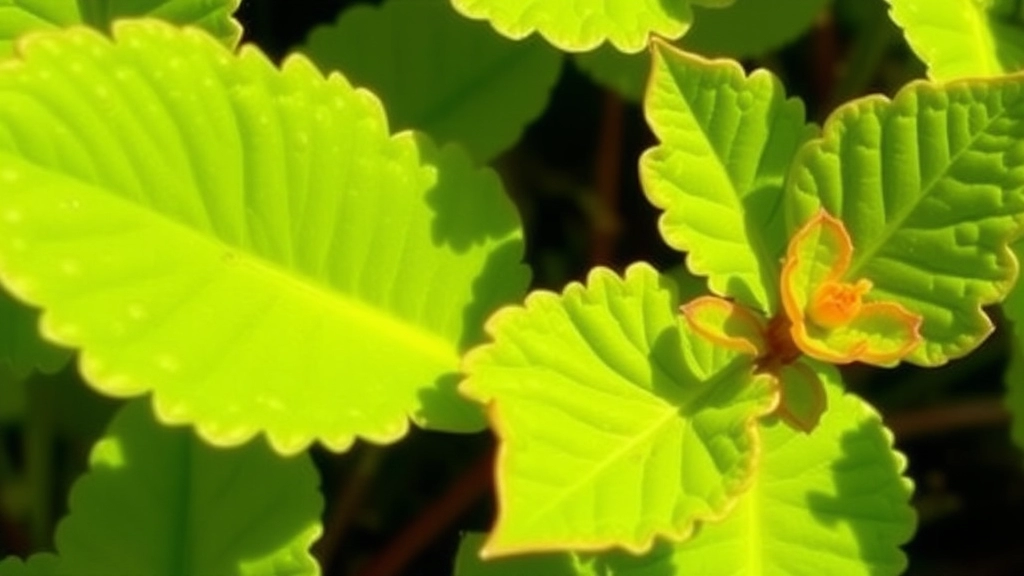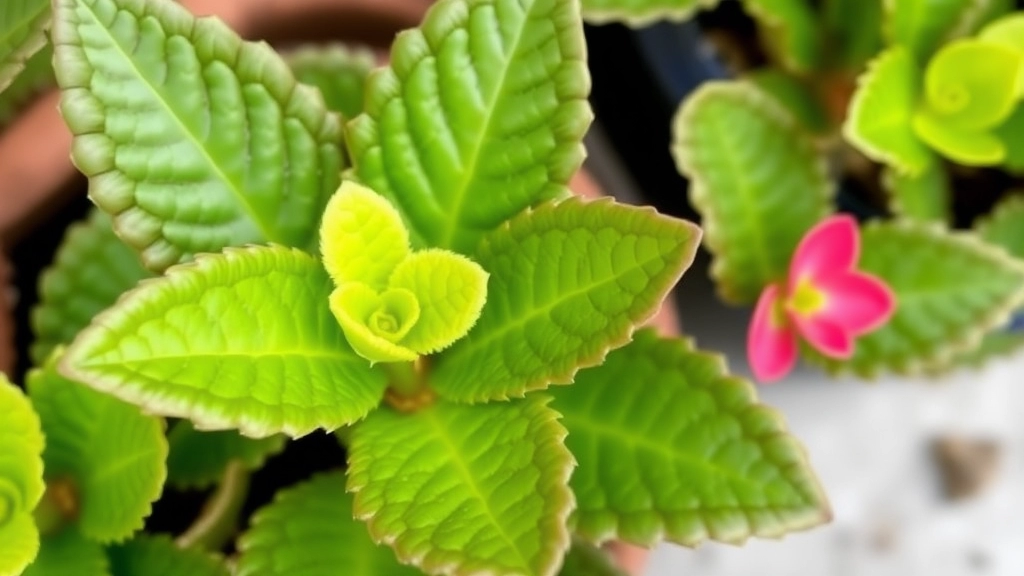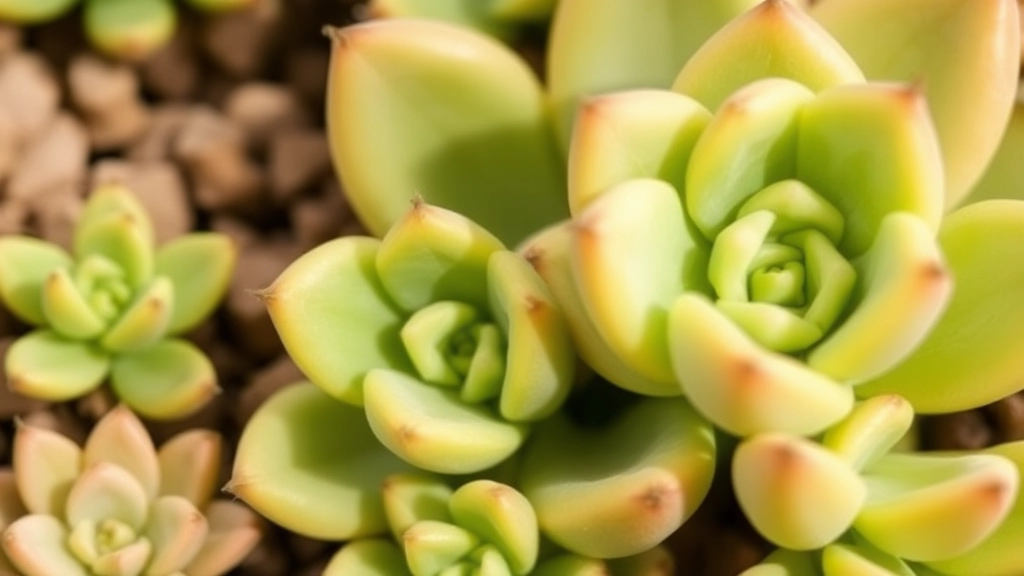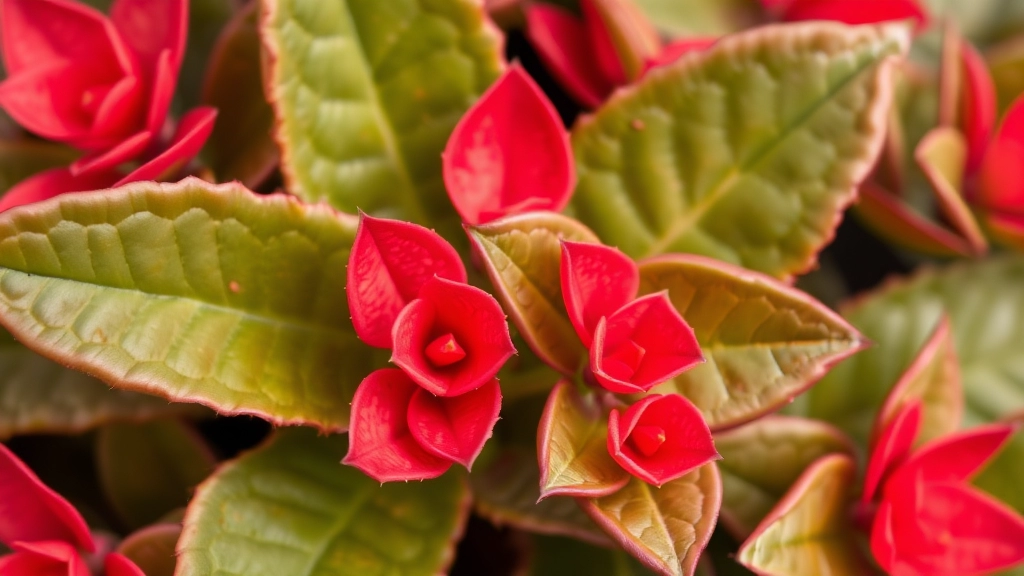Understanding Kalanchoe Leaves Turning Red
Are you puzzled by your kalanchoe leaves turning red? You’re not alone in this colorful conundrum. As a fellow plant enthusiast, I’ve encountered this issue and dived deep into understanding why these succulents sometimes decide to paint themselves crimson. In this article, we’ll explore the common causes behind this phenomenon, from sunlight exposure to watering practices, and provide practical solutions to keep your kalanchoe thriving.
We’ll uncover how factors like temperature, soil conditions, and even overfertilization can impact your plant’s leaf color. Whether you’re a seasoned gardener or a newbie plant parent, you’ll find valuable insights on maintaining your kalanchoe’s health and vibrant green hue. So, let’s embark on this journey to decode the secret messages your kalanchoe is sending through its reddening leaves.
Common Causes of Kalanchoe Leaves Turning Red
Ever looked at your kalanchoe and thought, “Why’s this thing going all red on me?” You’re not alone, mate. It’s a common head-scratcher for plant parents, and I’ve been there too.
Let’s dive into why your kalanchoe’s pulling a chameleon act:
- Sunbathing Gone Wrong
Your plant might be getting too much of a good thing. Too much sun can turn those leaves redder than a Brit on a Spanish beach. - Temperature Tantrums
These succulents can be right drama queens when it’s too hot or cold. Extreme temps? Red alert! - Thirsty Work
Underwatering’s a classic. Your kalanchoe might be sending out an SOS with those red leaves. - Soil Shenanigans
Poor soil? Wrong pH? Your plant’s not happy, and it’s showing it. - Overfertilization Overkill
Too much of the good stuff can be bad news. Overfeeding can lead to nutrient burn, and bam – red leaves.
Here’s the thing: red leaves aren’t always bad news. Sometimes it’s just your plant’s natural sunscreen kicking in. But if it’s looking more distressed than a football fan during penalties, it’s time to play plant detective.
In my experience, it’s usually a combo of these factors. I once left my kalanchoe out during a heatwave – rookie mistake. It looked like it had been to a rave, all red and stressed out. But with a bit of TLC, it bounced back.
Remember, plants are tough little buggers. They’re always trying to tell us something. Our job? To listen and act. So, let’s roll up our sleeves and get into the nitty-gritty of each cause. Trust me, by the end of this, you’ll be a kalanchoe whisperer.
Impact of Sunlight Exposure on Kalanchoe Leaves

Ever noticed your Kalanchoe leaves turning red? Sunlight’s often the culprit.
These succulents love light, but too much can be a problem.
Here’s the deal:
Kalanchoes need about 4-6 hours of bright, indirect sunlight daily.
Too much sun? The leaves go red as a defence mechanism.
It’s like the plant’s putting on sunscreen!
But here’s the thing:
A bit of redness isn’t always bad. It can make your plant look pretty cool.
However, if the leaves are getting crispy or brown, that’s a sign of sunburn.
So, what can you do?
- Move your plant to a spot with less direct sun
- Use sheer curtains to filter harsh light
- Gradually increase sun exposure to help your plant adjust
Remember:
Kalanchoes are tough cookies, but they still need our help sometimes.
Keep an eye on those leaves. They’re telling you what your plant needs.
Bottom line: Sunlight’s crucial for Kalanchoe blossfeldiana, but balance is key. If you’re looking for a unique variety, consider the Kalanchoe tomentosa ‘Teddy Bear’ for its charming, fuzzy leaves.
The Role of Temperature in Kalanchoe Leaf Color Changes
Ever noticed your Kalanchoe’s leaves going a bit red and wondered what’s up? Well, temperature’s often the culprit behind these colour shifts. Let’s dive into how the mercury affects your plant’s look.
Cold Snaps: When Your Kalanchoe Gets the Chills
Picture this: you’ve left your Kalanchoe out on a chilly night, and suddenly its leaves are sporting a reddish tinge. What’s going on?
- Cold stress is real for these succulents
- Temperatures below 10°C (50°F) can trigger colour changes
- It’s like your plant’s putting on a cosy jacket to cope
Heat Waves: Too Hot to Handle?
On the flip side, scorching temps can also turn your Kalanchoe’s leaves red. Here’s the lowdown:
- Extreme heat (above 35°C or 95°F) stresses the plant
- Red pigments act like sunscreen for the leaves
- It’s your plant’s way of saying, “Phew, it’s hot out here!”
The Goldilocks Zone: Just Right for Your Kalanchoe
So, what’s the sweet spot for keeping your Kalanchoe happy and green?
- Aim for temperatures between 15-25°C (60-77°F)
- Consistent temps are key – no wild swings!
- Think of it as your plant’s comfort zone
Quick Tips to Keep Your Kalanchoe Comfy
- Move it indoors when temps drop below 10°C
- Provide shade during heatwaves
- Use a thermometer to monitor its environment
Remember, a little colour change isn’t always bad. It’s your plant communicating. But if you want those lush green leaves, keeping the temperature steady is your best bet.
By understanding how temperature affects your Kalanchoe, you’re one step closer to being a plant whisperer. Keep an eye on those leaves – they’re telling you more than you might think!
How Watering Practices Influence Kalanchoe Leaf Health

Let’s chat about watering your Kalanchoe. It’s not rocket science, but get it wrong and you’re in for a world of hurt.
Too much water? Your plant’s gonna drown.
Too little? It’ll dry up faster than a puddle in the Sahara.
Here’s the deal:
Kalanchoes are succulents. They’re built to handle dry spells.
Overwatering is the number one killer. No joke.
Signs you’re drowning your plant:
- Leaves turning yellow
- Soft, mushy stems
- That funky smell of rot
On the flip side, underwatering ain’t great either.
Your plant will tell you it’s thirsty:
- Leaves get wrinkly
- They might drop off
- The whole plant looks sad and droopy
So, what’s the sweet spot?
Water when the top inch of soil feels dry.
Don’t just splash water on top. Give it a good soak.
Let excess water drain out. No one likes wet feet, especially Kalanchoes.
In winter, ease up. Your plant’s taking a breather.
Remember, it’s easier to save an underwatered plant than an overwatered one.
Bottom line: Watering impacts your Kalanchoe’s health big time. Get it right, and you’ll have a happy, thriving plant. If you notice your Kalanchoe leaves drying out, it might be a sign of underwatering. On the other hand, if you see Kalanchoe leaves falling off, it could indicate overwatering or other issues.
Soil Conditions and Their Effects on Kalanchoe Leaves
Hey there, plant pals! Let’s chat about how soil can make or break your Kalanchoe’s leaf game. Trust me, I’ve been down this road, and it’s not always pretty.
Why Soil Matters for Your Kalanchoe
So, you’ve got this beautiful Kalanchoe, right? But suddenly, its leaves are looking a bit… off. Maybe they’re turning red, or worse, yellow and droopy. Chances are, your soil’s trying to tell you something.
Here’s the deal: Kalanchoes are succulents, which means they’re not fans of sitting in wet socks (or soil, in this case). They need soil that drains faster than your bank account on payday.
The Soil Lowdown
Let’s break it down:
- Drainage is king: Your Kalanchoe wants soil that’s more like a quick shower than a long soak.
- pH matters: These guys prefer slightly acidic to neutral soil (around 6.0 to 7.0).
- Nutrients, but not too much: They’re not big eaters, so go easy on the fertilizer.
Signs Your Soil’s Not Cutting It
- Leaves turning red or yellow
- Droopy, sad-looking plant
- Roots looking brown and mushy (yuck!)
The Fix: Getting Your Soil Game On Point
Alright, let’s sort this out:
- Mix it up: Grab some regular potting soil and mix in perlite or coarse sand. Aim for about 50/50.
- Check the drainage: Make sure your pot has holes. No holes = sad Kalanchoe.
- Test the pH: Grab a soil tester from your local garden shop. It’s worth it, trust me.
Pro Tip: If you’re repotting, let the roots dry out a bit before planting. It’s like giving them a spa day.
Remember, folks, good soil = happy Kalanchoe = happy you. It’s that simple.
So, next time you’re wondering why your Kalanchoe’s leaves are turning red, take a peek at the soil. It might just be the root of the problem (pun totally intended).
Now, go forth and give your Kalanchoe the soil it deserves. Your plant will thank you, and you’ll be the envy of all your plant-loving friends. Cheers to healthy, vibrant Kalanchoes!
The Consequences of Overfertilization on Succulents

Hey there, succulent lovers! Let’s chat about a common oopsie: overdoing it with the plant food.
Overfertilizing your Kalanchoe? Big no-no.
Here’s the deal:
Too much fertilizer can mess up your plant’s whole vibe.
It’s like force-feeding your mate at an all-you-can-eat buffet. Not cool.
What happens when you go overboard?
- Leaf burn: Those edges start looking crispy. Ouch!
- Weird growth: Your plant might shoot up too fast, getting all leggy.
- Root damage: Too much salt in the soil can fry those delicate roots.
- Nutrient lockout: Ironically, your plant might start starving.
Signs your Kalanchoe’s had enough:
- Leaves turning yellow or brown
- Wilting, even when watered
- Slow growth or no growth at all
- White crust on the soil surface
Remember, Kalanchoes are tough cookies. They don’t need much pampering.
Less is more when it comes to feeding these beauties.
Stick to a light feed during growing season. That’s spring and summer, mates.
And in winter? Let ’em rest. No food needed.
Got it? Great! Your Kalanchoe will thank you for not stuffing it silly.
Next time you’re tempted to give extra fertilizer, just say no. Your plant will be happier for it. If you’re curious about other Kalanchoe varieties, check out the Kalanchoe blossfeldiana family for more information.
How to Adjust Light, Temperature, and Water for Healthy Growth
Alright, let’s get real about keeping your Kalanchoe happy and healthy. I’ve been there, scratching my head over why my plants look a bit off. But here’s the deal: it’s all about nailing the basics of light, temperature, and water. Let’s break it down, no fluff, just the good stuff.
Light: Finding the Sweet Spot
Listen, Kalanchoes are sun-lovers, but they’re not beach bums. Here’s how to get it right:
- Aim for bright, indirect light. Think of it as the plant equivalent of hanging out in the shade on a sunny day.
- If you’re keeping them indoors, a south-facing window is your best bet.
- Noticed your plant stretching? That’s its way of saying, “Hey, I need more light!”
- Too much direct sun? You’ll see those leaves turning red or getting scorched. Time to move it back a bit.
Temperature: Keeping It Comfy
Kalanchoes aren’t too fussy, but they do have their preferences:
- They’re happiest between 15-21°C (60-70°F). Think room temperature, and you’re on the right track.
- In winter, keep them away from cold drafts. No one likes sitting by a drafty window, plants included.
- If it’s too hot, they’ll start dropping leaves faster than I drop my phone.
Watering: The Goldilocks Approach
Here’s where most of us mess up. Kalanchoes are succulents, so they’re pretty chill about water:
- Let the soil dry out between waterings. Stick your finger in – if it’s dry up to your first knuckle, it’s watering time.
- Overwatering is a killer. Better to underwater than drown your plant.
- In winter, cut back on watering. The plant’s having a bit of a rest, so it needs less.
Pro Tip: Adjust for Seasons
Remember, your Kalanchoe’s needs change with the seasons:
- Summer: More light, more water (but not too much!), watch out for scorching.
- Winter: Less light, less water, keep it cosy but not too warm.
The Bottom Line
Getting these three things right – light, temperature, and water – is like hitting the plant care jackpot. It’s not rocket science, but it does take a bit of attention. Keep an eye on your plant, and it’ll tell you what it needs. Red leaves? Probably too much sun. Droopy? Might need a drink.
Remember, every plant’s a bit different, just like us. What works for one might not work for another. So, pay attention, make adjustments, and soon you’ll be speaking Kalanchoe like a pro. Trust me, once you get the hang of it, it’s a breeze.
Preventing and Treating Kalanchoe Diseases That Affect Leaf Color

Ever noticed your Kalanchoe’s leaves looking a bit off? Yeah, me too.
Let’s chat about keeping these beauties healthy and vibrant.
First up, prevention is key. Trust me, it’s way easier than dealing with sick plants later.
Keep your Kalanchoe in a spot with good air flow. Stuffy corners? Big no-no.
Water at the base, not on the leaves. Wet leaves are like a welcome mat for fungi.
Speaking of water, don’t overdo it. These guys hate soggy feet.
Now, if you’re already seeing issues, don’t panic. We’ve got this.
Spotted leaves? Might be leaf spot disease. Snip off the affected parts and dial back the watering.
Fuzzy white stuff? That’s powdery mildew. A bit of neem oil usually sorts it out.
Yellowing leaves could be root rot. Check the roots and repot if needed.
Remember, healthy plants resist disease better. So, give ’em the right light, water, and soil.
And hey, if you’re ever unsure, snap a pic and ask a plant pro. Better safe than sorry, right?
Keep an eye out for early signs. Catching problems early is half the battle.
With a bit of care, your Kalanchoe will be the star of your plant collection in no time!
Signs of Stress in Kalanchoe and How to Correct Them
Ever looked at your Kalanchoe and thought, “Mate, you’re not looking your best”?
Let’s chat about how to spot when your plant’s having a rough time and what we can do about it.
Stress signals in Kalanchoe? They’re like a plant’s way of waving a red flag.
Here’s what to watch for:
- Leaves turning red or yellow
- Wilting or drooping
- Leaf spots or discoloration
- Stunted growth
- Flower drop
Now, don’t panic. These issues are usually fixable.
Let’s break it down:
- Red leaves? Could be too much sun. Move it to a spot with indirect light.
- Yellow leaves? Might be overwatering. Let the soil dry out between waterings.
- Wilting? Check the roots. If they’re mushy, you’ve got root rot. Time for some plant surgery.
- Leaf spots? Could be a fungal issue. Snip off affected leaves and improve air circulation.
- Stunted growth? Your plant might be hungry. Give it a balanced fertilizer, but don’t go overboard.
- Flower drop? Temperature shock could be the culprit. Keep it away from drafts and sudden temp changes.
Remember, Kalanchoes are tough cookies. They can bounce back with a bit of TLC.
The key? Pay attention to your plant. It’ll tell you what it needs.
And hey, don’t beat yourself up if you make a mistake. We’ve all been there.
Gardening’s a journey, not a destination. Keep learning, keep growing, and your Kalanchoe will thank you for it.
Frequently Asked Questions about Kalanchoe Leaves Turning Red
Why are my Kalanchoe leaves turning red?
Kalanchoe leaves can turn red due to various factors, including excessive sunlight exposure, temperature stress, underwatering, or nutrient imbalances. It’s often a sign that your plant is adapting to its environment or experiencing some form of stress.
Is it normal for Kalanchoe leaves to turn red?
While some redness can be normal, especially in response to increased sunlight, significant color changes may indicate underlying issues that need attention. A little red tint isn’t always cause for concern, but dramatic changes warrant investigation.
How can I prevent my Kalanchoe’s leaves from turning red?
To prevent reddening, ensure your Kalanchoe receives appropriate light (bright but indirect), maintain consistent temperatures (15-25°C or 60-77°F), water properly (allowing soil to dry between waterings), and use a well-draining soil mix.
Does red coloration mean my Kalanchoe is dying?
Not necessarily. Red leaves are often a stress response, not a death sentence. However, if accompanied by other symptoms like wilting or leaf drop, it might indicate more serious issues that need addressing.
How much sunlight does a Kalanchoe need?
Kalanchoes thrive in bright, indirect light. They typically need about 4-6 hours of sunlight daily. Too much direct sun can cause leaf reddening and potential sunburn.
Can overwatering cause Kalanchoe leaves to turn red?
While overwatering is more likely to cause yellowing or browning, it can indirectly lead to reddening by stressing the plant. Underwatering is more commonly associated with reddening leaves in Kalanchoes.
How often should I fertilize my Kalanchoe?
Fertilize your Kalanchoe sparingly, typically once a month during the growing season (spring and summer) with a balanced, water-soluble fertilizer. Avoid fertilizing in winter when the plant is dormant.
Can temperature changes cause Kalanchoe leaves to turn red?
Yes, extreme temperatures or sudden temperature fluctuations can stress Kalanchoes, potentially causing leaves to turn red. Keep your plant in a stable environment, avoiding cold drafts or excessive heat.
References
-
Missouri Botanical Garden – Kalanchoe blossfeldiana Kalanchoe blossfeldiana

